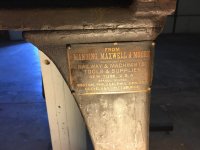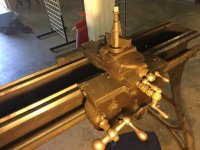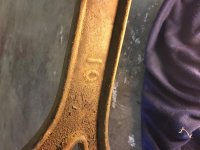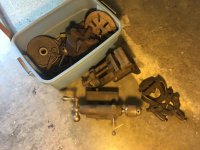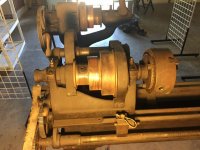How to install the app on iOS
Follow along with the video below to see how to install our site as a web app on your home screen.
Note: This feature may not be available in some browsers.
You are using an out of date browser. It may not display this or other websites correctly.
You should upgrade or use an alternative browser.
You should upgrade or use an alternative browser.
Got a F.EReed can find anything out any help will be appreciated
- Thread starter Top93
- Start date
- Replies 9
- Views 3,050
Joe in NH
Diamond
- Joined
- Jul 28, 2007
- Location
- Stratham, Cow Hampshire
Tony's Lathe site http://www.lathes.co.uk/ doesn't seem to have an entry for F.E. Reed.
Old Wood Working Machines VintageMachinery.org | Welcome now renamed Vintage Machines VintageMachinery.org | Welcome seems to have an entry for F.E. Reed. Check out F. E. Reed & Co. - History | VintageMachinery.org
From the 2nd link:
There are some pictures and some period literature at the site.
Another (good) place to check is Ken Cope's "American Lathe Builders" which has several pages on F.E. Reed.
Reed lathes were VERY popular in the 1880 to 1910 time frame. They bragged and were likely correct when they claimed "Reed Lathes went 'round the world!"
If this is your first experience using a lathe this period book is available online for free Text-book of advanced machine work : Smith, Robert H. (Robert Henry), 1852-1916 : Free Download & Streaming : Internet Archive and can be bought for small money (less than $20 delivered) as a used book from places like abebooks.com. Many of the illustrations and wood cuts in this book are taken directly from your Reed.
Be VERY careful with this lathe when you get it up and running. It is a survivor of the 19th century and has none of the guarding or other personal protection that a more modern machine has. And it has a 19th century attitude about eating and digesting your personal body parts. For protection you can cultivate a habit of working the lathe always "one handed" and leave that other hand in your pocket. Doing so slows you down to a 19th century speed, protects that hand, and makes you THINK about your next move - and you're more likely to shut the machine off before getting more personally involved.
And don't engage the lead screw AND the carriage feed clutch at the same time - an action that is sure to cause damage to the machine.
Good luck - and have fun!
Joe in NH
Old Wood Working Machines VintageMachinery.org | Welcome now renamed Vintage Machines VintageMachinery.org | Welcome seems to have an entry for F.E. Reed. Check out F. E. Reed & Co. - History | VintageMachinery.org
From the 2nd link:
From age 17, Frederick E. Reed worked for Wood, Light & Co., maker of iron-working machinery and power transmission equipment. In 1875 he bought an interest in the A. F. Prentice & Co. A couple of years later he bought the entire company and operated it under his own name. Reed oversaw a period of rapid expansion, and F. E. Reed became one of the biggest machinists' lathe makers in the world. In 1891 his foreman, John R. Black, became a partner and the firm added "& Co." to the name.
There are some pictures and some period literature at the site.
Another (good) place to check is Ken Cope's "American Lathe Builders" which has several pages on F.E. Reed.
Reed lathes were VERY popular in the 1880 to 1910 time frame. They bragged and were likely correct when they claimed "Reed Lathes went 'round the world!"
If this is your first experience using a lathe this period book is available online for free Text-book of advanced machine work : Smith, Robert H. (Robert Henry), 1852-1916 : Free Download & Streaming : Internet Archive and can be bought for small money (less than $20 delivered) as a used book from places like abebooks.com. Many of the illustrations and wood cuts in this book are taken directly from your Reed.
Be VERY careful with this lathe when you get it up and running. It is a survivor of the 19th century and has none of the guarding or other personal protection that a more modern machine has. And it has a 19th century attitude about eating and digesting your personal body parts. For protection you can cultivate a habit of working the lathe always "one handed" and leave that other hand in your pocket. Doing so slows you down to a 19th century speed, protects that hand, and makes you THINK about your next move - and you're more likely to shut the machine off before getting more personally involved.
And don't engage the lead screw AND the carriage feed clutch at the same time - an action that is sure to cause damage to the machine.
Good luck - and have fun!
Joe in NH
northernsinger
Titanium
- Joined
- Aug 19, 2004
- Location
- New England
Good information from Joe above.
I( own a small Reed lathe made up for wood working, a hand lathe.
I( own a small Reed lathe made up for wood working, a hand lathe.
James H Clark
Stainless
- Joined
- May 11, 2011
- Location
- southern in.
Why are there no shots of the headstock or drive?
JH
JH
johnoder
Diamond
- Joined
- Jul 16, 2004
- Location
- Houston, TX USA
Here is 1899 Rose, which may have some coverage. My 1901 edition has extensive Reed coverage.
Modern machine-shop practice: operation, construction, and principles of ... - Joshua Rose - Google Books
Modern machine-shop practice: operation, construction, and principles of ... - Joshua Rose - Google Books
IrbyJones
Stainless
- Joined
- Jun 9, 2005
- Location
- Poquoson, Va
Looks like you got yourself a nice early (1890-1907) 10" lathe, FE Reed was based out of Worcester Ma (I have the next version 18" which was introduced in 1908). FE Reed started as AF Prentice Machinery, became FE Reed, then Reed & Sons, Reed-Prentice and finally Prentice Brothers. The Reeds of Worcester had a family of related companies.
One had a foundry (not sure of the name)
One had the Machinery (FE Reed)
Then you had Reed Small Tools, who did instruments (Calipers, Micrometers, Scales, Etc...) that became Tubular Micrometer Co, then Sherr-Tumico. Both current types of micrometers (flat and cast bodies) originated at RST, not sure which others tools have been carried over.
Finally you had Reed Manufacturing who handled tooling, and is also still in business making tools for the plumbing industry.
Looks like you have everything except the primary drive cone for the lineshaft overhead. as far as controls go, on the apron, under the cross slide you have a pull knob that sends power to the cross slide and the traverse, the Tee handle below engages and disengages the power. The handle on the right end is the half nuts to directly power traverse off the feed screw. At the left end there should be a leather belt connecting the spindle to the lead screw pulleys.
Regards,
Rich C.
One had a foundry (not sure of the name)
One had the Machinery (FE Reed)
Then you had Reed Small Tools, who did instruments (Calipers, Micrometers, Scales, Etc...) that became Tubular Micrometer Co, then Sherr-Tumico. Both current types of micrometers (flat and cast bodies) originated at RST, not sure which others tools have been carried over.
Finally you had Reed Manufacturing who handled tooling, and is also still in business making tools for the plumbing industry.
Looks like you have everything except the primary drive cone for the lineshaft overhead. as far as controls go, on the apron, under the cross slide you have a pull knob that sends power to the cross slide and the traverse, the Tee handle below engages and disengages the power. The handle on the right end is the half nuts to directly power traverse off the feed screw. At the left end there should be a leather belt connecting the spindle to the lead screw pulleys.
Regards,
Rich C.
Similar threads
- Replies
- 4
- Views
- 424
- Replies
- 22
- Views
- 1K
- Replies
- 13
- Views
- 585


